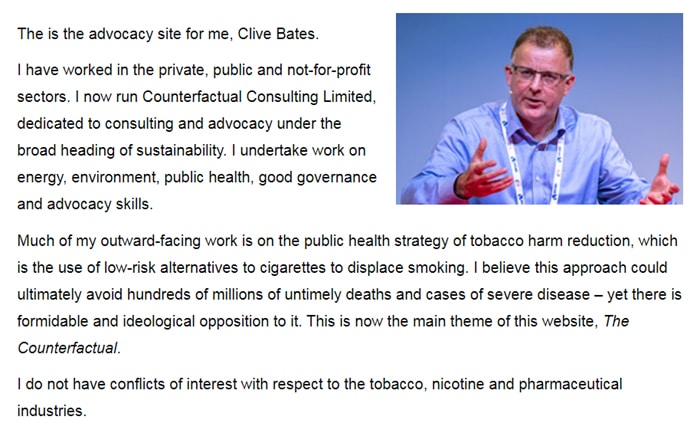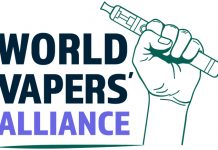In my “THR Superstar” interview series I have so far chatted to some wonderful advocates.
This time we have the one and only Clive Bates!
He is very prominent in THR (Tobacco Harm Reduction) and you will no doubt have seen articles, videos or social media posts of him standing up for those of us who use safer nicotine products.
Tell me a little about your life and career so far…
I was brought up in the Manchester area, studied Engineering at Cambridge University and then Energy and Environmental Policy at Imperial College, London.
I started my career at IBM as a systems engineer but made a dramatic career shift into activism, leaving the corporate world to join Greenpeace as an energy campaigner. Never regretted it!
In 1997, I started as Director of Action on Smoking and Health (ASH), campaigning for tobacco control measures as the New Labour government came into office. After about six years, I moved to the civil service, to Tony Blair’s Strategy Unit and then onto some other civil service roles with the Environment Agency, the United Nations in Sudan, and the Welsh Government, where I had the sustainability brief.
Since 2013, I’ve had my own sustainability consultancy and advocacy practice, Counterfactual. I’ve spent the past eight years in Africa, in Zimbabwe and then Nigeria, but since April, I have been back in the UK, living in Derbyshire.
Have you been a smoker? If so, how long did you smoke for?
I’ve never smoked. But my dad did, and he smoked for long enough for it to kill him. He died in 2010 from heart failure after a lingering decline at least ten years before his time. He loved technology and was a 1960s computer industry pioneer. If vaping had been a thing when he was in his 40s or 50s, I’m pretty sure he’d be alive today.
Do you vape? If so, when did you start? What was your first kit?
I don’t vape and have never used nicotine or tobacco in any form – not even tried it. I was really put off by the smoke-filled rooms of my youth.
The first kit I bought was for a friend, and I hoped he’d quit smoking – it was a refillable system. It wasn’t a great experience, to be honest – too complicated, too much jargon and too difficult to use from day one. It didn’t work for him. Thankfully, that’s changed a lot.
How did vaping change your life?
Vaping has changed my life, mainly by driving me mad.
More precisely, I am finding the opposition to vaping is incredibly exasperating and frustrating. It is hard to process what I am seeing from supposedly reputable people and organisations.
Having worked in ‘tobacco control’ in the past, I’m completely appalled by the anti-vaping backlash, the pitiful science and the blatant misinformation. I think the loud mainstream of tobacco control is now worse than the tobacco industry ever was, though, to be fair, many are quietly working hard to do the right thing.
Is tobacco control the new Big Tobacco?
In their frantic opposition to safer forms of nicotine use, the tactics of tobacco control activists seem eerily familiar.
New blog: https://t.co/r6DplUMX5x
— Clive Bates (@Clive_Bates) September 12, 2023
What kits stand out for you in your vaping journey and what is your current set up? What kind of device do you prefer?
I don’t vape, but my philosophy is the best vape is the one that works for you, whoever you are. Different people will want different products in differing circumstances and at different points in their journey out of smoking. I’d also extend that to heated tobacco, pouches and snus.
It’s never a pretty sight to see one part of the vape community railing against the smoke-free choices of others. I think everyone should support everyone else’s choices.
Right now, I’m in the relatively lonely position of being positive about disposables. For some people, they solve a lot of problems: low price and upfront cost, ease of use, good flavour and competitive nicotine delivery. That’s worth a lot if it helps more people start their vape journey and quit smoking.
What flavour is your preference?
I don’t vape, so I don’t have a personal preference. However, from a public health point of view, my preference is “diversity” in flavours. I say, let a thousand flowers bloom.
As with pizzas, life would be dull if the only topping was a margarita, even if that is a popular and tasty topping. The regulators who say, “Well, adults can just use tobacco flavour” are wholly missing the point. It’s the choice that makes it interesting.
When did you first become involved in vaping advocacy / tobacco harm reduction and why?
I first became involved in tobacco harm reduction in about 1998. As Director of ASH, I was campaigning to lift the EU snus ban (unsuccessfully) and to widen the range of indications for NRT products (successful).
I really got into vape advocacy around 2013 when it became clear to me what a big deal vaping would become. I wasn’t involved, but I was completely taken aback by the grassroots vaper campaign against the UK MHRA’s first attempt to medicalise and ban vaping in 2010 (see the vaper responses to MLX 364).
My first real battle was over the European Union Tobacco Products Directive (TPD), an epic struggle in which thousands of vapers prevailed over the main EU institutional drive for regulating vapes as medicines. Had it happened, that would have been a killer blow.
What current roles do you hold within THR?
I do what I can in the time available with the resources I have, trying mainly to focus outside the UK. There are some great public health people and academics in the UK; the problems are mainly elsewhere. As I don’t really have an institution, don’t represent anyone, and I’m not a made-for-media scientist, I tend to stay out of the public limelight and work behind the scenes.
I run a couple of networks and produce regular information and analysis, such as a weekly review of scientific papers related to THR. I didn’t really want to get involved and thought I had left it behind in 2003, but the idea that we could squander this gigantic huge health opportunity was too much to bear.
What current projects / campaigns are you working on?
The FCTC COP-10 is a big deal, obviously, though it is pretty difficult to influence it – it’s mostly about saluting the right lags, the grandstanding is strong, and the echo chamber is heavily reinforced. The best outcome is no outcome.
My 5-part advice for delegates to #COP10 FCTC tobacco treaty.
Summary: Approach COP10 with scepticism, not cynicism, with clarity about national goals and tough questions about trade-offs, unintended consequences and evidence. https://t.co/pocjQn7CXx@WHO @FCTCofficial
1/7
— Clive Bates (@Clive_Bates) September 3, 2023
At the moment, I’m interested in the developing situations in South Africa and Brazil and hope to do more to address the arguments against THR in low and middle-income countries (the arguments are actually strongly in favour), and I’m always interested in how it all plays out in Africa.
Blog: South Africa’s self-harming anti-vaping legislationhttps://t.co/2vJYr8yuLJ
South Africa is consulting on tobacco control legislation that is so extreme and punitive that it would do more harm than good. What’s wrong with it, and what is the role of foreign influence?
— Clive Bates (@Clive_Bates) September 4, 2023
The next EU directive is coming over the horizon, and it does not look nice.
I am also keen to make sense of the challenges of the nicotine market and industry transformation. I hope we can develop a more compelling account of what must be done to and by the companies in the field to bring the lethal era of the cigarette to a close.
Finally, nicotine without (much) harm should change the way society thinks about this relatively benign drug. My last few conference appearances have focussed on ‘rethinking nicotine’.
What do you feel needs to change regarding tobacco harm reduction Worldwide?
Conceptually, there needs to be one big widely accepted change – and it goes beyond tobacco harm reduction. We need collectively to understand that the demand for nicotine is robust and will not go away; it needs to be thought of more like caffeine or moderate alcohol consumption. The demand for nicotine is more permanent and resilient than any particular way of taking it. Within that insight lies the potential to save at least 100 million lives.
Any countries you feel are succeeding in THR?
No one is coming close to realising the full potential, though, of course, there are bright spots in England, New Zealand and a few others. But we should never consider these countries to be at the frontier of what is possible – they are far from it.
So I don’t really like to hold these up as models. They are mostly just “less bad” than others. Even if a country tried to go “all in” on THR, the flow of misinformation and outright propaganda percolating through global media means that no country could exploit THR to its maximum potential.
How would you advise vapers to get involved and stand up for their rights?
- Join a consumer group – they will help you know when and how to intervene to the best effect in what can sometimes be bewildering processes (waves at Brussels).
- Be authentic – tell it as you see it in your own words drawing on your own experience. Back it up with facts if you can, but your experience is what counts. Don’t use automatically generated messages.
- Keep it polite – given what we have to endure, that can be a struggle, but never slip into personalising arguments. It never works.
- Get off social media. Twitter and Facebook are good for organising and keeping up, but change comes from the steady slog of influencing politicians, officials, businesses, news media etc.
Have you ever been “star struck” meeting people who you admire – if so who?
Not really. One quality I admire in people is their ability to put others at their ease, including and especially me!
I admire Tony Blair and worked in his wider team – he is a kind of political and policy superstar for me, but on the few occasions I met him, he was always very engaging and welcoming.
What is your proudest moment in your advocacy career?
8th October 2013, the defeat of the EU effort to medicalise vapes.
After a massive campaign by vapers and a bunch of renegade pro-THR comrades in public health, the European Parliament voted down the preferred position of the European Commission, the European Council (member states) and the lead committee of the parliament itself. Thousands were involved, and everyone shares the credit. I am just proud to have done my bit.
What would be a campaign you would love to start if there were no obstacles?
Two thoughts…
I would like to persuade Michael Bloomberg to see sense and change his mind. Or if he can’t do that, perhaps he could just stop what he is doing and exit. That would be a game-changer.
Then I’d like to work on the ‘rethinking nicotine’ agenda – perhaps an honest conversation about its possible benefits (or at least why people use it) and getting beyond the tired label “addiction” to describe its use and place in society. The people who have it most wrong are those who think a ‘nicotine-free society’ is within reach or even a desirable goal. They have learnt nothing from drug wars or their own consumption of psychoactive substances, typically caffeine or alcohol.
Who is the biggest enemy when it comes to tobacco harm reduction?
Michael Bloomberg. Not a second of hesitation there. A billionaire with strong views on public health that are more often wrong than right, yet he is fuelling a worldwide anti-vaping frenzy with hundreds of millions of dollars based on simplistic misunderstandings.
These are the real-life stories that should stimulate curiosity and excitement in tobacco control. Yet many will go off to work, completely indifferent to this experience, powered by billionaire money, untroubled by doubt, and determined to make sure it never happens again. https://t.co/VF65fsZ1aA
— Clive Bates (@Clive_Bates) September 22, 2023
Institutions such as the World Health Organisation have been captured, and many individuals have fallen for his money, or the sheer weight of disinformation his money has spread. Yet he is unaccountable and closed to challenge and discussion. As one critic put it following our attempts to engage with him, Michael Bloomberg likes data. Except when he doesn’t.
Is there a message you would like to give our readers?
Despite the daily turmoil, it’s all going to be okay. Just keep the faith and vape on. If you were a smoker, you are saving your own life on your own initiative and at your own expense. Ultimately, no one can or will take that away from you. If you are choosing to use nicotine, that’s your call.
Most of the anti-vaping activists will be downing coffee in the morning and swilling wine in the evening. They have no moral case for their righteous indignation at your choices.
Finally if you could give an “Ecigclick Award” to any person, product or company in the vaping industry / advocacy circle – who / what would it be?
For science: Professor Martin Jarvis (UCL) patiently taught me about nicotine and how to think about smoking, nicotine and harm when I worked at ASH. He will always be my ‘go-to’.
For a product: the lithium-ion battery – vaping and heated tobacco became viable as spin-offs from improved battery energy and power density.
For an advocate: Colin Mendelsohn (Australia) – amazing guy, I don’t know how he does it.
Thank You
Thank you so so much Clive, I know what a busy fella you are so I am very happy you took the time to answer my questions.
Also thank you also for all you do to stand up for those who want to use safer nicotine products. We are all so very grateful!
You can reach Clive Bates on Twitter / X – Clive_Bates
LinkedIn – https://www.linkedin.com/in/clivebates
Or on his Counterfactual website here – https://clivebates.com/










